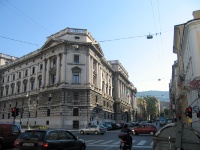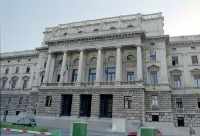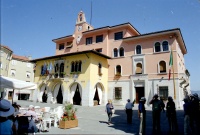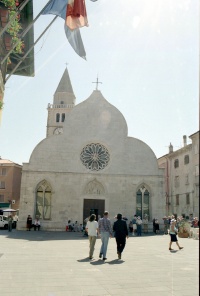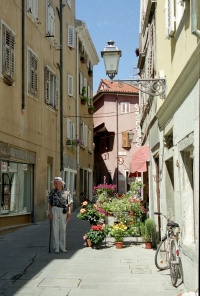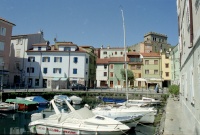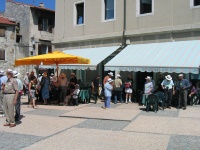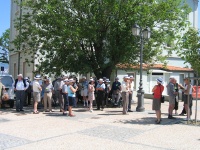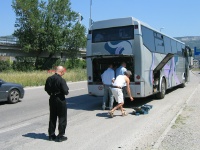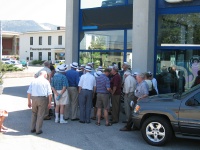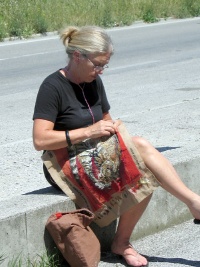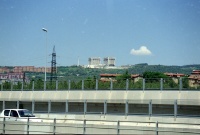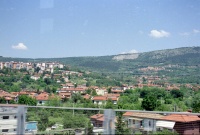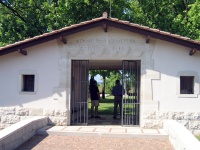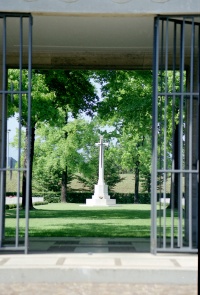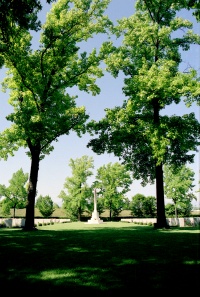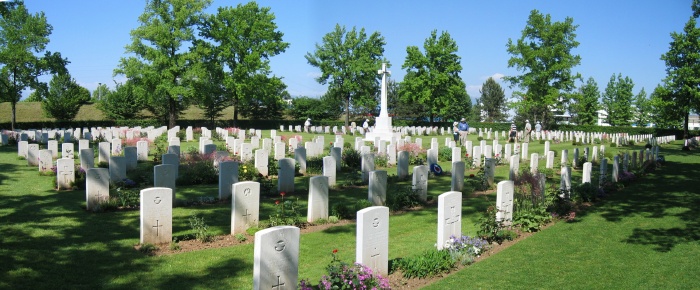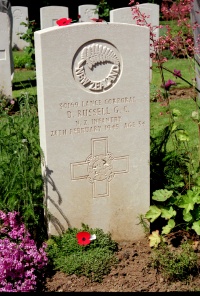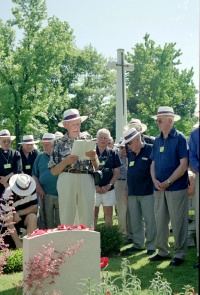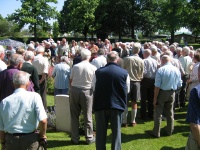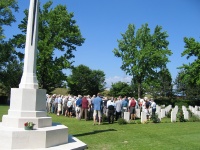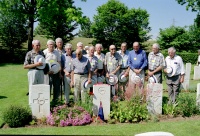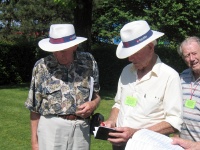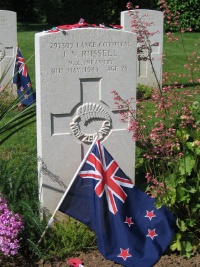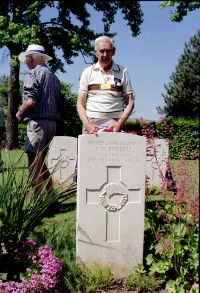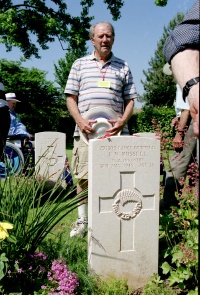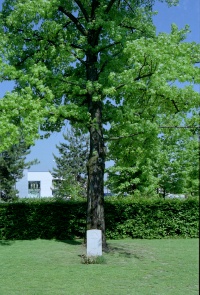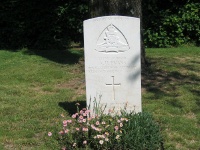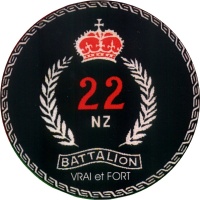
22nd Battalion 2NZEF
"Vrai et Fort"
WEEK 1
DAY 7 Friday 27 May 2005
The Tribunale Building and Departure from Trieste
For Colonel Donald and the New Zealanders who first arrived in Trieste, the Tribunale (Law
Courts) building was occupied by belligerent SS officers who refused to
surrender. To quote the Official
History
|
"At the Tribunale Donald could not persuade the garrison commander to
surrender; he was an SS officer who ‘was still humbugging undecidedly and was
apparently under the influence of alcohol. Donald therefore arranged
with the Yugoslav commander that tanks of C Squadron of 19 Regiment and C
Squadron of the 20th would surround the building and give it a 20-minute pounding with
their guns and Brownings. First the square was cleared of all troops and
civilians, and at 7 p.m. 18 tanks at ranges of from 20 to 50 yards blew gaping
holes in the walls and through the windows of the Tribunale. The Germans took
shelter in the cellars and had few casualties, but the Yugoslavs entered the building
and by morning had rounded up some 200."
|
In his reply to the mayor's address at the Tuesday Reception, Colonel Donald acknowledged
the damage he had ordered to the Tribunale and voiced his regret that he had been
forced to damage such a magnificent building. He was pleased to see that it had
been fully restored.
Before the buses departed this morning we walked up to the Tribunale.
|
The Tribunale
|
Front of the Tribunale |
There is more information about the Tribunale, and more photographs
of its damage here.
Muggia
We boarded the buses at 0920, departed at 0945 for Muggia, a small ancient town beside the border
with Slovenia. Apparently some of the New Zealand troops had been billeted
there prior to their return home. Many of us found the visit to Muggia rather
disappointing and somewhat pointless - The two hours would have been better
spent visiting Ponte di Piave where we had high expectations of
visiting the local cemetery and viewing the brass plaque to Russell who had been
awarded the George Cross for bravery here. The plaque had been funded a few years
prior by New Zealanders, many of whom were on this tour. But this
highlight of the tour was not to be.
|
The Town Hall in Muggia |
The old Church across the piazza from the Hall |
Flowers in a side street |
|
Part of the Harbour at Muggia |
Ice cream time |
Waiting for the buses at Muggia |
Soon after departure from Muggia, the air conditioning on Bus 1 (our bus!) broke down and the
temperature in the bus climbed to dangerous levels. We stopped beside the road for repairs,
effectively preventing any possible diversion to Ponte di Piave later in the day.
|
Surgery time on Bus 1 |
Listening to the story of David Russell GC while the surgery continued |
Another way of passing the time |
Once repaired we were off towards Udine, passing around the outskirts of Trieste, then climbing the hills to the northwest.
As we left Trieste, we had some final views of the hills.
|
From the autostrada, looking across to the new Trieste Hospital |
Looking across the hill suburbs of Trieste |
Udine Cemetery
Udine Military Cemetery, a few miles north of Trieste is where many of the Commonwealth troops
killed in the area are buried. Udine was the first cemetery our tour had reached, and
for many it was their first opportunity to visit a war cemetery
maintained by the Commonwealth War Graves Commission. Everybody was impressed with the
upkeep of the cemeteries, the neat rows, the mowed grass and the well-tended roses and other flowers.
|
The entrance gate to Udine Cemetery |
Looking through the gates to the Cross of Sacrifice |
The avenue of grass leading to the graves |
|
A panorama of the Cemetery at Udine |
At Udine we were especially interested in two graves - both named Russell, both Lance Corporals,
both from the 22nd Battalion and both buried in the same row.
David Russell GC
David Russell, as an escaped prisoner of war, was shot by the Germans on 28 February 1945 at Ponte di Piave. He was
buried in that town, but his body was later moved to Udine. He was awarded the George
Cross for his bravery in the face of the Germans - the only New Zealander to receive this honour in the war.
There is more information and further photographs here.
|
David Russell's headstone - note the different style of headstone with
the usual cross replaced by the George Cross and the wording
"For Gallantry" |
Doug Froggatt reading the George Cross citation for David Russell |
The group around David Russell's grave |
|
Russell's grave |
Fellow members of the 22 Battalion beside David Russell's grave |
Doug & Haddon compare notes |
John Russell:
John Russell was killed by a Yugoslav mortar while A Company was trying to negotiate the surrender
of the German Garrison at Villa Opicina, in Trieste. His death on 3 May 1945
is widely regarded as the first casualty of the Cold War, the Germans having surrendered on 2 May.
To quote from the Official History:
| About half past eight that morning 3 May, after a message was received from the commander of the 1200-strong
German garrison at Villa Opicina, a village a couple of miles north of Trieste,
A Company of 22 Battalion and three tanks of A Squadron of 20 Regiment
were sent to negotiate the surrender. One of the tanks was ditched on
the way, and the infantry three-tonners could not pass a demolition,
but the two remaining tanks carried a platoon up the road. Here again
the Germans were willing to become prisoners of the New Zealanders but
not of the Yugoslavs. While the company commander (Captain Wells) was
negotiating with the Germans, the Yugoslavs opened up with mortars and
small arms. A Company came under fire, ‘and to the sorrow and anger of
the battalion,’ Lance-Corporal Russell was killed and
another man wounded |
| 
